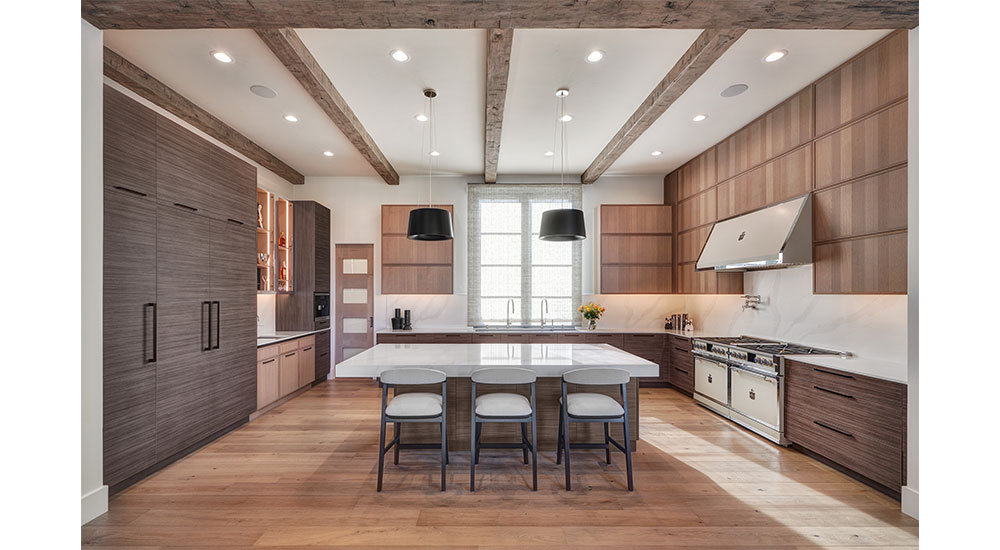Working as an interior designer is exciting, rewarding and creatively fulfilling, however, one challenge many of us face is the risk of being shopped by clients. This refers to the practice of presenting your design concepts, completed designs and product proposals to your client, and in turn, they take these elsewhere in search of a better deal or result. This not only wastes valuable time and resources that go into producing a design but also undermines the value of professional designers and can be a loss of business. Fortunately, there are several tips you can use to avoid being taken advantage of in this way and build strong client relationships.
Above photo: Tall ceilings and the modern rustic architecture of this home inspired this luminous kitchen design by Nar Design Group. The client’s goal was for it to feel warm and inviting for daily cooking and for frequent entertaining. The floor-to-ceiling frameless cabinetry was designed to emphasize and celebrate the ceiling height and to let the gorgeous Italian range and hood become the focal point of the space.
Photo credit: Fred Donham, PhotographerLink
Create a Process to Prequalify Your Clients
The best way to save yourself from wasted time is to prequalify and vet your potential clients. An initial screening phone call is a great way to understand their goals for their project and allows you to determine whether they are serious about working with your firm. Filtering out unqualified leads early gives you the best chance of acquiring clients that appreciate and value the design process.
Protect Yourself from the Beginning
Some potential clients will try to pick your brain for design ideas before committing to your firm or signing a design contract. Be protective of your creative ideas and have boundaries on how much you are willing to share. If you give up too much information early on, the client may not see the value in signing up for your services and take the ideas elsewhere.
Educate the potential client on your design process and services and show them examples of your work. This gets them excited about seeing an end result with you. If you put value on the table by explaining to them exactly what they get from start to finish, it gives them confidence to make a commitment.
Charging up front for design services ensures that you are compensated for your time from the start, even if your clients do try to shop the project. If they see the worth in hiring a design professional, they’ll sign up and pay the fees. If they are hesitant or unwilling to invest in the design services from the start, they’re likely to exhibit that behavior throughout the design process.
Ascertain a Strong Reputation & Specific Purpose
Establishing your business with a strong reputation will allow you to avoid getting shopped. If you have a specific purpose, such as quality and high-level design, you become known for this, and clients will come to you for this reason. It sets the expectation and reduces the chance of clients trying to shop for a cheaper alternative elsewhere once the design is complete.
Building an impressive portfolio and displaying your work on your website showcases your experience and builds trust in your expertise, while also ensuring the potential client aligns with your design style. With high-level design, clients also expect a high level of communication. Maintaining professionalism by being clear about deliverables, meeting deadlines and having prompt and detailed responses makes you easy to work with and won’t give clients any reason to take their business elsewhere.
Develop Strong Relationships with Builders & Architects
By establishing these partnerships, you create a network of trusted professionals who understand your skills, work ethic and creative approach. This mutual trust forms a foundation of reliability, which can lead to more consistent work and fewer chances of clients seeking alternatives. Working closely with a trusted team also allows for efficient problem solving, building confidence in the client that they are being taken care of and in the right hands.
Foster Client Relationships Beyond the Project
While delivering exceptional design work is important for winning a project, maintaining and fostering client relationships throughout and after the project is completed shows you are committed and can also create potential for repeat business and referrals. Once they have built trust in you and there is a mutual respect, they have a greater sense of loyalty to return for future projects and share your name with others.
While getting “shopped” by clients can be frustrating, it can be avoided with the right strategies in place. By prequalifying potential clients, charging for your expertise and building strong relationships with your clients and builder partners, you can significantly reduce the possibility. As a designer, it’s important to protect your creative work, build trust and ensure that clients see the value in working with you long-term. By following these tips, you can create a successful and positive experience for both you and the client.
By Kacie Atkinson, Chief Design Officer of Nar Design Group,









